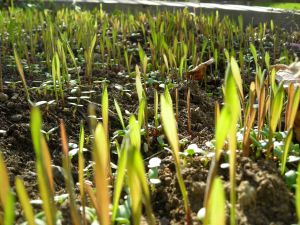
fall rye & crimson clover
Another gorgeous fall morning. November first, I can’t believe it! We have had some rainy weather this past week or so and one of our first proper fall storms. Here in Vancouver we have typically mild, but yucky winter weather. On Friday we had one of those winter storms where you get the wind blowing in such a way that an umbrella will do you no good; the rain falls sideways.
That’s ok though. My cover crops need the rain. And now the sun is out they are sure to take off today.
As you can imagine, growing a yard full of vegetables has its draw backs. There are lots of biennial and over-wintering veg – garlic, onions, winter greens, the kales and cabbages . . . But most veggies are usually grown as annuals which means lots of big bare brown patches of earth in the yard come fall.
This is a problem for a number of reasons. The fact that it’s pretty boring and ugly is probably the first to come to my neighbours’ minds . . . But for me I think – Eek! Unprotected soil!!
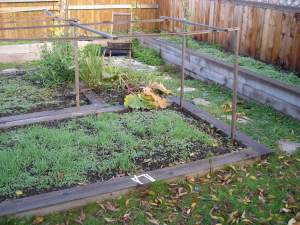
cover crops keep the yard looking tidy
All of those glorious west coast winter rains means that our soil is already on the acidic side (perhaps one day I’ll get into the bio-chem of that, but believe me, Sunday morning is no time to talk about ions.) The soil and plants need rain, of course, but too much means that all those nutrients we worked so hard to get into the soil are simply going to wash away, toot-suite. Not to mention the soil itself might end up in the storm drain instead of the beds where it belongs. So. What to do?
The answer is cover crops, or green manure.
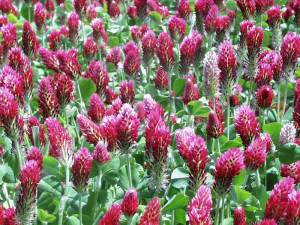
crimson clover
As you can imagine, it would probably take an awful lot of compost to cover my garden. Even sheet composting would require heaps and heaps of organic matter to do the job. You have to remember that as organic matter decomposes, it looses it’s water content and shrinks accordingly. Cover crops provide a means to address all of the problems of bare winter beds.
First of all – it keep things in place. The soil won’t run away if it’s held tight by a nice root system. Secondly, rather than being left in the soil to be washed away by the rain, the nutrients will be held in the plants themselves. An added bonus, lots of cover crops are nitrogen fixers.
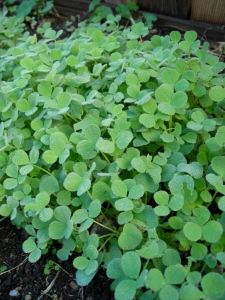
a swath of crimson clover
This is another bio-chem class that is probably better left for another day but the gist of it is – some plants are really good homes for bacteria which make the nitrogen in the soil available to the plants. As with everything in the garden, if we stay out of the way, we will find that there are plenty of pre-existing symbiotic relationships that already have figured out the answers to all of a gardener’s problems. So why reinvent the wheel?

fall rye seeds
There are lots of options for cover crops; oats, almost any kind of legume like peas or beans, clovers, various cereal grains, you name it. Your seed supplier will help you chose which crop or combination of crops are best for your site and your climate. Be aware the seeds can be tricky to find at regular garden shops; you will likely have to contact a seed company directly. As usual, we love Westcoast Seeds.
There really is nothing to using cover crops. In late summer / early fall after you have pulled the last of your veg, toss some seed into your prepared bed, lightly rake it in, and you’re done! Come spring, about six weeks before you plan to plant your bed, dig the cover crops under. This will give you enough time to get the crops decomposing. By doing so you will not only return all those nutrients to the soil, but also add bulk and organic matter.
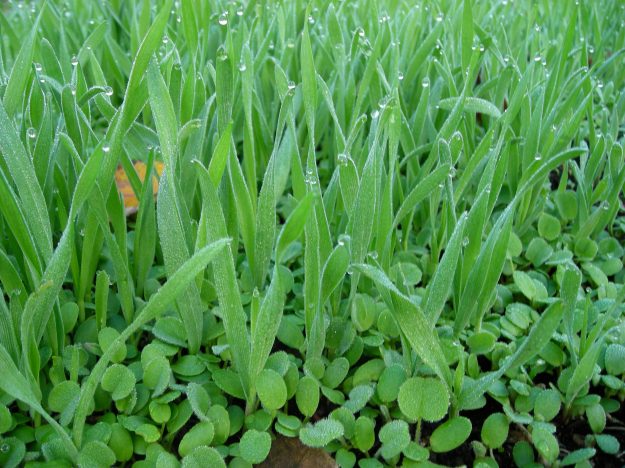
fall rye in the morning dew
We chose to use fall rye in our front yard because the soil there is very poor and lacking organic matter, having been nothing but sod for so many years. Fall rye grows quickly and will add a huge amount of bulk to the soil. It is also a mild nitrogen fixer. Added bonus? Fall rye gives off a chemical that stops other seeds from germinating – no weeds!
Our backyard has been used as vegetable gardens by previous owners and so the soil is pretty rich already. So instead of rye there we chose to use crimson clover, a great nitrogen fixer that will ensure we return all of the nutrients to the soil that our veg took out of it this summer.
Overall cover crops and green manures are an easy way to maintain soil health over the winter, no matter how large or small your plot of land.